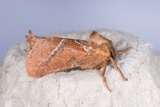Triodia sylvina (Linnaeus, 1761) Species
Last modified: Aug. 31, 2025, 10:07 a.m.
This species is, throughout Belgium, the most common species of the Hepialidae family.
This species is considered Least Concern according to the IUCN Red List category for Flanders 2023.
Details
- Classification
- Family: Hepialidae > Genus: Triodia > Species: Triodia sylvina
- Vernacular names
- Oranje wortelboorder (NL), Orange Swift (EN), Sylvine (FR), Ampfer-Wurzelbohrer (DE)
- First mention in Belgium
- De Sélys-Longchamps E. 1837. Catalogue des Lépidoptères ou Papillons de la Belgique, précédé du tableau des Libellulines de ce pays. — — : 1–29. On page 24 (as Hepialus Sylvinus). view page
- Status
-
Native
Distribution
Imago
The size of T. sylvina is very variable and its wingspan ranges from 31 to 49 mm. In this species, especially in the male, the forewings are orange-brown and carry two narrow, fairly straight and uninterrupted dark-edged whitish diagonal lines that form an inverted 'V'. However, these lines do not touch. The wing cilia are not chequered. The female is slightly larger and is less contrasting coloured than the male. As in all other Hepialidae species, the antennae are remarkably short and the moths lack functioning mouth parts so they cannot feed.
Caterpillar
The shiny and dirty-white caterpillar has an orange-brown head and somewhat paler thoracal plates. The stigmata are dark brown to black.
Bionomics
Females of this species scatter their eggs over plants as they fly over them in a suitable biotope. The larva lives on the roots of small herbaceous plants and probably also on grasses. This species hibernates twice as a larva and pupates in the ground. The adults come readily to light.
Flight periods
The adults fly from July till mid-September, but the main flight period is in August. This is considerably later in the year than the other species of this family.
Observed on
- Host plant (genera):
- Pteridium, Taraxacum and Rumex
- Substrates:
- Herbaceous plants
The larva lives in the roots of various small herbaceous plants like Rumex spp., Taraxacum spp., Pteridium aquilinum, and probably also Gramineae.
Habitat
This species inhabits moorland, waste ground and other wild places.







